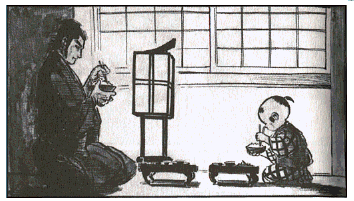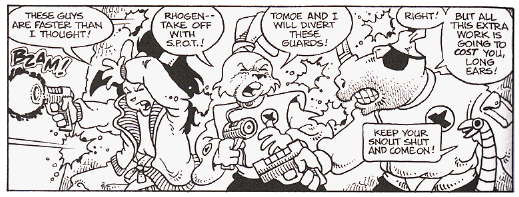

| May 2001 |
|
| Kazuo Koike & Goseki Kojima: Lone Wolf and Cub | |
 The lead character is an assassin in 17C Japan, Itto Ogami, who travels the country plying his trade... along with his tiny son Daigoro. We soon learn that he was once the shogun's kaishakunin executioner, the samurai charged with beheading nobles who had just committed seppuku. (Paradoxically, seppuku is an honorable death precisely because it's such a painful way to die; yet the beheading is done so as not to prolong the agony. Well, I suppose it's like an income tax refund: you're entitled to it precisely because you've performed the painful sacrifice of tax withholding.)
The lead character is an assassin in 17C Japan, Itto Ogami, who travels the country plying his trade... along with his tiny son Daigoro. We soon learn that he was once the shogun's kaishakunin executioner, the samurai charged with beheading nobles who had just committed seppuku. (Paradoxically, seppuku is an honorable death precisely because it's such a painful way to die; yet the beheading is done so as not to prolong the agony. Well, I suppose it's like an income tax refund: you're entitled to it precisely because you've performed the painful sacrifice of tax withholding.)
The powerful Yagyu clan murders Ogami's family and forces him out of his position. He offers his infant son a choice, by placing a toy ball and a sword before him. Daigoro crawls toward the sword, sealing their fate... they will together travel the demons' road, Meifumado.
In form, Lone Wolf is a series of short stories-- variations on a theme of death. Ogami faces one formidable opponent after another, and exercises considerable ingenuity in order to find and dispatch his victims. Perhaps the most interesting stories are those involving Daigoro (who is sometimes used as bait, or gets himself in trouble when his father is away). Ogami obviously believes in the 'take your child to work' ideal, and it makes the child uncannily calm and collected.
It's also a fascinating tour of medieval Japan-- a sea of squabbling han, controlled though not exactly ruled by the Tokugawa shogunate in Edo. Koike's research is impressive; after a few volumes you'll feel right at home counting koku and sizing up a dotanuki.
The art is realistic and expert, and often dramatic. (If you're scared of the big-eyes school of manga, try this instead.) It's in black and white, though some shaded pages suggest that parts of it were originally published in color.
The series is addictive, but I'm still deciding how much I like it. Ogami is something of a moralist-- most of the time his victims are evil people; and when his employers are the bad guys he usually finds a way to ensure that justice is done. He's also admirably devoted, in his tough-guy way, to his young son. It's the Chanderlian formula of redemption amid crime and violence... but, well, the setup requires that almost every problem be solved by murdering someone. Koike and Kojima do their best to come up with clever and affecting variations on the theme, but it's probably best to read no more than one volume at a time.
Update: Further thoughts after reading the whole series.
| Stan Sakai : Space Usagi | |

(Little backstory is presented; this doesn't much matter while you're reading, but afterward you might wonder why nothing but Japanese culture seems to exist in this world. That makes sense for medieval Japan, an island, but not in space.)
It's a lot of fun, extremely readable-- I read it virtually in one sitting. The characters are predictable but strong; I especially liked Usagi's love interest, Tomoe, as well as the Han Solo-like smuggler, Rhogen, a rhinoceros.
Likably, since it was conceived as a one-shot story, it doesn't suffer from the usual pop culture requirement that each episode end with no change in the basic situation or the characters-- a stricture that allows the episodes to be consumed in any order, but renders the series as a whole devoid of movement. Important things happen in Space Usagi, which imparts a larger sense of drama.
The art is accomplished, though rather cartoony. You might expect from this that the story is comic; but it really isn't-- it's straight-ahead adventure, with only the lightest comic relief. (I'm not even sure why Sakai uses funny animals. I suppose he finds them fun to draw.)
